Jackie Damrau, Editor
Doing Visual Analysis: From Theory to Practice
by Per Ledin and David Machin
The Senses: Design Beyond Vision
by Ellen Lupton and Andrea Lipps, eds.
Business Management for Engineers: How I Overcame My Moment of Inertia and Embraced the Dark Side
by Alan C. Tribble, Ph.D., with Alan F. Breitbart, MBA
Metadata Essentials: Proven Techniques for Book Marketing and Discovery
by Jake Handy and Margaret Harrison
The Stress Test: How Pressure Can Make You Stronger and Sharper
by Ian Robertson
365 Technical Writing Tips
by Keith Johnson
Telling the Design Story: Effective and Engaging Communication
by Amy M. Huber
In Other Words: A Coursebook on Translation
by Mona Baker
Thinking Globally, Composing Locally: Rethinking Online Writing in the Age of the Global Internet
by Rich Rice and Kirk St.Amant, eds.
WordPress for Journalists: From Plugins to Commercialisation
by LJ Filotrani
Applied Artificial Intelligence: A Handbook for Business Leaders
by Mariya Yao, Marlene Jia, and Adelyn Zhou
Ethics and Practice in Science Communication
by Susanna Priest, Jean Goodwin, and Michael F. Dahlstrom, eds.
Archive That, Comrade! Left Legacies and the Counter Culture of Remembrance
by Phil Cohen
Don’t Be Such a Scientist: Talking Substance in an Age of Style
by Randy Olson
Scholarly Communication: What Everyone Needs to Know®
by Rick Anderson
The Paper It’s Written On: Defining Your Relationship with an Editing Client
by Karin Cather and Dick Margulis
Introducing Science through Images: Cases of Visual Popularization
by Maria E. Gigante
Breaking Down Barriers: Usability, Accessibility and Inclusive Design
by Pat Langdon, Jonathan Lazar, Ann Heylighen, and Hua Dong, eds.
A Connected Curriculum for Higher Education
by Dilly Fung
Doing Visual Analysis: From Theory to Practice
Per Ledin and David Machin. 2018. Thousand Oaks, CA: SAGE Publications. [ISBN 978-1-4739-7299-5. 208 pages, including index. $37.00. (softcover).]
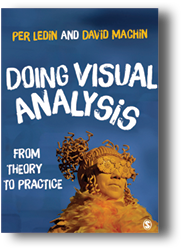 Doing Visual Analysis: From Theory to Practice opens with the authors first discussing visual communications. In that discussion, Ledin and Machin cite leading books on visual analysis from the humanities and science academic disciplines as well as textbooks on visual communication.
Doing Visual Analysis: From Theory to Practice opens with the authors first discussing visual communications. In that discussion, Ledin and Machin cite leading books on visual analysis from the humanities and science academic disciplines as well as textbooks on visual communication.
Keep in mind that humanities and science disciplines may use the same terms, but their terms, explication (definition of terms), operationalization (ways terms are measured), analysis (quantitative or qualitative), and interpretations often vary greatly and can be radically different.
In Chapter 2, the authors position their book as in the humanities field of social semiotics. More specifically, the next six chapters focus on how they apply social semiotic analysis as a tool to analyze the social meaning of domains (photographs, document design, packaging, space design, film clips and data presentation).
To illustrate, in Chapter 3, they divide the photographic functions into photojournalism and art, then discuss the symbolic (uses) of photographs within each function.
Ledin and Machin suggested the intended uses—the purposes of photographs. Their discussion then focuses on analyzing denotation and connotation of photographs, objects within photographs and their functions, color. Under color, the authors explore modulation (flatness of photographs), saturation (intensity of color), purity (basic colors—red, yellow, for example, range (different colors used), and coordination (how colors link image content together). They then discuss photographic settings (location or events) and participants (individuals or groups), categories, generic versus specific groups or categories, and lack of representations. Next come consideration of actions and indexical links (emotional, verbal, and material processes). To close, they consider the position of the viewer, including horizontal angles, oblique angles, proximity, and gaze.
The chapter closes suggesting research questions. Ledin and Machin point out that the questions asked will then determine the required analysis of the photographs being analyzed.
Analysis of the domains follows a similar pattern of first identifying the function, then considering a range of factors to be considered for analysis of that domain. The authors devote one or more narrative paragraphs exploring factors to consider.
What I found lacking were guidelines on how to summarize the analysis of the factors and interpret the meaning derived from the analysis.
Doing Visual Analysis is best for classes devoted to semiotics that first provide an overall guidance and background on its methodology and then explore specific topics under each domain. Then, Doing Visual Analysis could be used to explore the complexities of specific domains (kinds) of visual communications.
Technical communicators might find this book useful because the authors discuss a range of factors that could be considered when using specific domains.
Donald R. Zimmerman
Don Zimmerman is an STC Fellow and Jay R. Gould Award recipient. He taught technical communication classes and conducted research at Colorado State University’s Department of Journalism and Technical Communication. Don’s 150 publications include journal articles, book chapters, technical reports, presentations, newspaper and magazine articles, media productions, and books.
The Senses: Design Beyond Vision
Ellen Lupton and Andrea Lipps, eds. 2018. Hudson, NY: Princeton Architectural Press. [ISBN 978-1-61689-710-9. 224 pages, including index. US$30.00.]
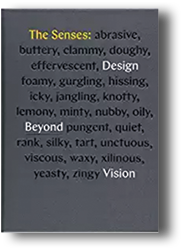 Inclusive design is a hot topic now, and designers are becoming more and more aware of the need to be inclusive with their designs. In April 2018, the Cooper Hewitt, Smithsonian Design Museum featured an exhibit titled The Senses: Design Beyond Vision; this exhibit argues that by including other senses, beyond vision, with design, solutions tend to be more inclusive in nature. To accompany the exhibition, the Cooper Hewitt, along with editors Ellen Lupton and Andrea Lipps, produced a book of essays by the same name.
Inclusive design is a hot topic now, and designers are becoming more and more aware of the need to be inclusive with their designs. In April 2018, the Cooper Hewitt, Smithsonian Design Museum featured an exhibit titled The Senses: Design Beyond Vision; this exhibit argues that by including other senses, beyond vision, with design, solutions tend to be more inclusive in nature. To accompany the exhibition, the Cooper Hewitt, along with editors Ellen Lupton and Andrea Lipps, produced a book of essays by the same name.
The essays within The Senses explore the nature of our senses and their application to design. These essays vary in length with some taking a less formal approach as some tend to read more like a slide presentation which is missing the presenter to unify the ideas for us. The book’s subtitle is emphasized due to the current nature of design, which focuses currently on sight.
The Senses directs designers to consider the other senses: touch, taste, smell, and sound, as well as to take steps to remedy this common neglect of the other senses. The overarching theme, proposed by Caroline Baumann, Director of Cooper Hewitt, in the Foreword states, “When designers open up to multiple sensory dimensions, products and services reach a greater diversity of users” (p. 6). In other words, when we incorporate senses, more than just vision, we are open to creating a more inclusive design.
This book is well designed for designers and by designers, with the result being subtle, yet beautiful. The cover is black with the title in yellow and the subtitle in white, with an assortment of words used to describe sensory experiences slightly debossed with a spot varnish that makes these words fall to the background, allowing the title and subtitle to stand out with a nice effect. Inside the book, the theme of black, white, and yellow is continued, with the prominent colors being white pages with black text, and yellow being reserved for the first page of some essays or to call out information within the text. A subtle yellow line is used to underline text within the essays and is a very nice detail that designers will appreciate. Full color images accompany the essays and illustrate many of the thoughtful sensory solutions contained in the book.
The Senses offers inspiration to designers who are interested in being both more inclusive and including sensory experiences within their designs. It also challenges designers to think more along these terms, leaving one with the feeling that this is just the beginning and that we will see more sensory design in the future.
Amanda Horton
Amanda Horton holds an MFA in Design and currently teaches graduate and undergraduate courses at the University of Central Oklahoma in the areas of design technology, design studio. and history of graphic design. Ms. Horton is also the director of the Design History Minor at UCO.
Business Management for Engineers: How I Overcame My Moment of Inertia and Embraced the Dark Side
Alan C. Tribble, Ph.D., with Alan F. Breitbart, MBA. 2018. Marion, IA: Alan C. Tribble. [ISBN 978-1-7321545-0-6. 218 pages, including index. US17.95 (softcover).]
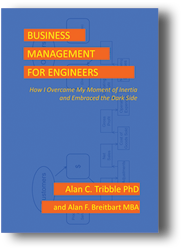 Intense as it is, technical education fails to teach that engineering is fundamentally a utilitarian, economic activity. However advanced or intrinsically interesting technical innovation may be, its economic viability—and the justification for its existence—ultimately depends on someone rarely considered in the engineering curriculum—the customer.
Intense as it is, technical education fails to teach that engineering is fundamentally a utilitarian, economic activity. However advanced or intrinsically interesting technical innovation may be, its economic viability—and the justification for its existence—ultimately depends on someone rarely considered in the engineering curriculum—the customer.
Once on the job, the engineer begins to realize that “there is always a business aspect to any engineering project”; that “taking ownership” of a project requires you to “treat it like a business—even better, to treat it like your business (which it is)”; and to consider not only the “inherently cool technical details,” but also the “necessary, and equally cool, business details” (pp. xiii–xv).
The engineer needs to develop a solid understanding of business, not only because “Business and engineering go hand in hand,” but also because understanding this principle will make the engineer “more successful as an engineer” (p. xii). The most successful engineers can discuss deeply technical details with other specialists and “explain what all of that technical analysis means to the business” (p. 70).
Such engineers realize that the risks associated with the most advanced technology, though necessary and worthy of investment, must be complemented by market-driven technical incrementalism, because “you only need to be slightly better than the competition to gain a much larger market share” (p. 43). That is, sustaining the business is a prerequisite for the investment in more exciting, but riskier, disruptive technologies and products.
Tribble extensively surveys the basics of financial and cost accounting, business models, planning, forecasting, reporting requirements, intellectual property, organizational structures, legal issues, globalization, and project and program management tools such as statements of work and scheduling—essentially providing a “how-to” for the beginning engineer. Learning that a product must have a value proposition achievable only through a judicious trade-off between time (schedule), resources (money), and features (technology), focuses the engineer’s technical efforts on achieving the greatest financial return. The engineer’s economic focus also increases his value to the company, his productivity, justifying a higher salary than newly graduated engineers with nominally the same skills.
The emphasis on defense and aerospace in Business Management for Engineers: How I Overcame My Moment of Inertia and Embraced the Dark Side is less directly relevant to purely commercial enterprises but applying the rigor and systematic approach of government work would keep many start-ups out of trouble. More thorough planning and simple evaluative metrics, consistently applied, would increase the likelihood of creating a sustainable business (pp. 179–199).
Downloads of the figures and tables are available online. Tribble himself is available for training sessions. Business Management for Engineers should be required reading for all engineers, especially entrepreneurial types, who could more successfully grow their business by using the planning and management techniques Tribble illustrates.
Donald R. Riccomini
Donald R. Riccomini is an STC member and a senior lecturer in English at Santa Clara University, where he specializes in teaching engineering and technical communications. He previously spent twenty-three years in high technology as a technical writer, engineer, and manager in semiconductors, instrumentation, and server development.
Metadata Essentials: Proven Techniques for Book Marketing and Discovery
Jake Handy and Margaret Harrison. 2018. Berkeley, CA: Graphic Arts Books. [ISBN 978-1-5132-6089-1. 136 pages, including index. US$12.99 (softcover).]
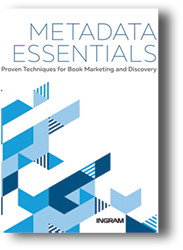 Are you an author or a staffer in a publishing company who is having trouble getting bookstores, libraries, and individual readers to understand what your books offer or even realize that they exist? One solution might be Metadata Essentials: Proven Techniques for Book Marketing and Discovery, a how-to resource distributed by Ingram Content Group.
Are you an author or a staffer in a publishing company who is having trouble getting bookstores, libraries, and individual readers to understand what your books offer or even realize that they exist? One solution might be Metadata Essentials: Proven Techniques for Book Marketing and Discovery, a how-to resource distributed by Ingram Content Group.
Metadata are bits of data that differentiate one object from another. You tap into metadata when, for example, you search your photos by location, date, shutter speed, file size, and keywords. When marketing your book, you tell bookstores and libraries its description, theme, audience, style, awards, and more.
Metadata experts Jake Handy and Margaret Harrison both work at Ingram, the major industry force in getting your book to the right people. (Company job advertising states, “If you are reading a book, Ingram Content Group is probably behind it.”) Metadata Essentials is an Ingram tool “to help publishers and authors prioritize their metadata efforts and to demystify the way that booksellers, discovery sites, search engines, and libraries catalog, market, and merchandise your book” (p. 5). Your key takeaway, then, is how to use metadata so that others can discover your book.
The two main chapters provide deep detail heavily supported by graphics. The lengthy Chapter 2, “Take Action! Metadata Essentials, Your Step-by-Step Guide,” defines and generously illustrates various metadata attributes: titles, contributors, long and short descriptions, subject codes, international thema, audience information, rights, images, and more. A tabular metadata checklist early in the chapter briefly annotates the most important attributes; unfortunately, it sits next to another table that ranks attributes differently. Each kind of attribute gets a shaded half-page box that ticks off the basics, quick tips, importance of its components, and retailers’ input.
The authors offer dozens of best practices, such as “Use at least 7 keyword phrases, semicolon separated with no space after the semicolon” (p. 70). Most interesting are the pages on devising keywords and writing descriptions. Be prepared for lengthy discussion of the ONIX XML metadata formats and codes and BISAC (Book Industry Standards and Communications) codes.
Handy and Harrison’s main contribution is Chapter 3, “Major Bookseller Profiles.” They use the results of in-depth interviews to create colorful, detailed tables showing precisely to what degree 14 major retailers use 24 data elements in selecting products. You get a set of “Smart Tips” for each retailer. For instance, “if your book is missing a cover image, it won’t be carried at Walmart.com” (p. 85).
The disappointing chapter “Metadata & Libraries” uses no graphics beyond bulleted lists. A problem for the writers is that this chapter has no connection to their interview results, so that they reproduce what we’ve heard before: the Dewey and Library of Congress classification schemes, the assignment of reading levels, and book review sources.
The book includes a glossary, which is serviceable except that it omits ONIX, a major term in their discussion that the authors never directly define. Much more useful is the deep index.
The book is not a smooth, easy read, with much unhelpful white space and inconsistent treatment of the captions of the many illustrations.
As a database person submerged in metadata, I happily greet this book’s publication. As an editor and writer, however, I know that the information deserves greater editorial attention.
Avon J. Murphy
Avon J. Murphy is a technical editor in western Washington. A retired college professor and government writer, he is an STC Fellow, a contractor, and principal in Murphy Editing and Writing Services, specializing in computer and Web technologies. Avon served as book review editor for Technical Communication for 17 years.
The Stress Test: How Pressure Can Make You Stronger and Sharper
Ian Robertson. 2018. New York, NY: Bloomsbury Publishing. [ISBN 978-1-4088-6039-7. 246 pages, including index. US$17.00 (softcover).]
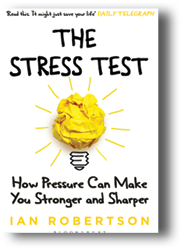 The Stress Test: How Pressure Make You Stronger and Sharper is a spectacular tale of the psychological and physiological science behind Fredrich Nietzche’s maxim: “What doesn’t kill me, makes me stronger.” Robertson draws the reader in with stories of patients, the why behind it all, and how the reader can use this information to be “stronger and sharper” through adversity.
The Stress Test: How Pressure Make You Stronger and Sharper is a spectacular tale of the psychological and physiological science behind Fredrich Nietzche’s maxim: “What doesn’t kill me, makes me stronger.” Robertson draws the reader in with stories of patients, the why behind it all, and how the reader can use this information to be “stronger and sharper” through adversity.
Specifically, Robertson explains the competing right and left sides of our brains and how to use this information to our advantage. For instance, “Our physical movements mirror our mental states. One of the fundamental mental states is desire and the inclination to get nearer to the object of our desire” (p. 87). Robertson refers to this phenomenon as the “approach mode,” which is a key aspect of the brain’s left side. You can harness this knowledge to your advantage by gently squeezing a rubber ball in your right hand to increase activity in the left side of the brain which will “make you more positive and put you in “approach mode” (p. 110). This approach mode primes your brain for reward giving you a temporary confidence boost. Further, by activating the brain’s left side, you are inhibiting the right side which is responsible for anxiety. The simple act of squeezing the ball in your right hand can alter your physiology which will make you feel more confident and less anxious. This is specifically useful before a challenge. Robertson even shared that he used a “power pose” with a “right fist clenched” before a TEDx talk in which he was feeling anxious to help him give a “nerveless performance” (p. 111).
As illustrated with the ball, “what you do affects how you feel” (p. 102). So, it is especially intriguing that “bodily feelings are so similar across different emotions, we often don’t get a clear answer and so have to deduce the emotion from the context” (p.116). Therefore, with self-awareness you can actually “rewrite” the context of your emotions because the physical responses to excitement and nervousness are very similar. For example, “saying ‘I am excited’ in the face of nervous arousal switches your brain into approach mode by creating a challenge or opportunity mindset” (p. 126) and improves performance. On the other hand, saying “I feel anxious” switches your brain into avoidance mode which “focuses your mind on the possible downsides of the situation” (p. 126) and decreases performance. Robertson drives this home when he writes, “Emotion arises, in part at least, out of how we think about the situation we are responding to” (p. 145). Therefore, your thoughts can determine how you feel and, in turn, your performance.
Robertson does a phenomenal job at explaining how our thoughts and actions determine our physiology and how to best use that information to our advantage. Each chapter elaborates on the prior chapters to further explain the complex science behind stress. The Stress Test is a must read especially for anxiety, stress prone individuals such as me.
Sara Buchanan
Sara Buchanan is an STC member that serves as the NEO STC community newsletter editor and is the membership manager for the IDL SIG. She is a Technical Writer at LCS is Cincinnati, OH for the software, Rent Manager.
365 Technical Writing Tips
Keith Johnson. 2018. Hollywood, FL: CreateSpace Independent Publishing. [ISBN 978-1-7210-3619-6. 168 pages. US$9.95 (softcover).]
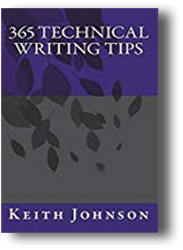 Quite eponymously, Keith Johnson’s new book is an encyclopedia of tips for the newbies in the technical communication arena. It can also work as a general reference book for the experienced professionals.
Quite eponymously, Keith Johnson’s new book is an encyclopedia of tips for the newbies in the technical communication arena. It can also work as a general reference book for the experienced professionals.
In 365 Technical Writing Tips, Johnson deals with tools, techniques, people and process. As Dave Lance, in the Prologue states: “It addresses the craft of technical writing. It supports you in the role of user advocate” (p. 17). In the Introduction, Johnson declares: “About half of the tips in this book are writing-specific. The other half are insights, resources and strategies that can be used to expedite your technical documents” (p. 20).
Building on the decades-long experience in the field, Johnson has comprehensively collated all information that may involve a technical writer in any field. Sometimes, the discussions may seem little redundant, but the intersection of responsibilities among different role players in a project team can easily be justified.
A comprehensive list of the broader categories into which the 365 tips fall in can read like this: 1) Abbreviations/Acronyms in the technical writing domain, 2) Authoring and image-capturing tools (both open-source and licensed), 3) Working practices, 4) Methodologies adopted in software development environment, 5) Professionalism in corporate culture, 6) Core documentation (writing, editing and review), and 7) English language skills.
The detailed, alphabetically arranged Table of Contents that spans over 14 pages perhaps makes up for the absence of an index that is essential for a reference book.
Many may find this book to be a pleasant surprise in seeing that the tips also cover some generic professional tips that may be helpful to people of any profession. For example, drive safe to the office and exercise daily—these tips do not have any direct correlation to the responsibilities of a technical writer.
For some interesting reason, Johnson has included a host of tips for Microsoft Office and Microsoft Visio tools. Similarly, the tips such as Meditation, Technical Writing (p. 69), My favorite time (p. 86), My favorite question: Why? (p. 87), Staying Motivated (p. 120), Time is Valuable (p. 126), and Understanding Magic (p. 128) may appear to be very generic to the readers, with less direct links to technical writing. Yet those new to the technical communication field may find those as important values that may help shape their career well whereas the experienced technical communicator may revisit the basics.
Many of us would agree with the disclaimer in the introduction where Johnson affirms this book “is neither personal nor professional advice, in any way. This book is for reading enjoyment only” (p. 20).
Arun Dash
Arun Dash works as a Principal Technical Author for AVEVA India LLP based in Hyderabad, India. With over a decade of technical writing experience, he has experimented with writing for various domains. He is a continuing Research Scholar in English (under the guidance of Dr. Leena Lilian) at KIIT (deemed to be) University, Bhubaneswar.
Telling the Design Story: Effective and Engaging Communication
Amy M. Huber. 2017. New York, NY: Focal Press. [ISBN 978-0-415-78554-9. 244 pages, including index. US$39.95 (softcover).]
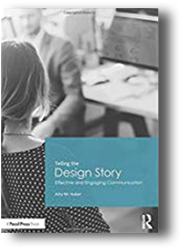 Technical communication is often undervalued, underfunded, and not well understood, and the prospect of using storytelling techniques to persuade decision-makers and garner support is exciting and promising.
Technical communication is often undervalued, underfunded, and not well understood, and the prospect of using storytelling techniques to persuade decision-makers and garner support is exciting and promising.
Telling the Design Story: Effective and Engaging Communication starts with three chapters that cover topics such as the human response to story, audience analysis, and story structure and design. Huber lays a strong foundation for using storytelling to create a visceral resonance and to facilitate the processing of information: “…our brains have an innate desire to organize information, and stories can help us link information into a series of events, then align those events with our own experience” (p. 7).
Her approach is refreshingly interdisciplinary. Huber includes authoritative references (such as Edward Tufte and Nancy Duarte) and provides persuasive evidence based on a wide variety of sources that include rhetorical history, psychology and cognition, marketing, graphic design, film-making, and more.
Her writing style is clear and approachable, with just a touch of humor. For example, in the chapter on public speaking, she writes, “The good news is you’re presenting to human beings, not malicious alien-creatures” (p. 92). Huber includes direct instructions that are easy to follow, and the content is structured into a teachable form, with exercises and specific questions that allow readers to focus on discrete, achievable tasks.
Unfortunately, the teachable form often feels contrived. For example, Huber writes about the “6 E’s of Information Engagement,” and has changed “Information Clusters” to “Enformation Clusters” and “E-nformation Chunking” to create a mnemonic (pp. 104-105) that is more distracting than useful.
While the interdisciplinary approach is refreshing, the selection and treatment of topics feels uneven and disorienting. The topics range from basic and remedial (such as the structure of a paragraph) to specialized and more advanced (such as video production). Some relevant topics are neglected or discussed only briefly (such as PowerPoint presentations, which are ubiquitous and often mandatory in corporate environments). The subject shifts without enough transitions from design storytelling to design itself, and even wanders into job interviews and personal branding.
For practicing technical communicators, Huber’s advice is sometimes dangerously oversimplified. For example, she declares that the use of active or passive voice can make “the difference between sounding confident or cowardly” (p. 61). Such declarations can lead to practitioners who dogmatically avoid passive voice, even when it’s appropriate.
The biggest disappointment is the lack of design-story examples; while the book includes a few descriptions of design stories, it does not include the actual stories.
Overall, Telling the Design Story is a structured but somewhat shallow introduction to many aspects of information development with a deeper focus on storytelling and video production. As a survey of effective communication methods, it is valuable for students in all areas of study, if the students are guided by an instructor who treats the book as an entryway into the more sophisticated approach taken in many of the cited texts.
Tina Kister
Tina Kister is an STC member and a specialist in effective, healthy business communication. Her approach is to facilitate success in others by building trust, streamlining processes, and delivering products that exceed expectations. Tina’s areas of expertise include technical writing, visual design, project management, and process improvement.
In Other Words: A Coursebook on Translation
Mona Baker. 2018. 3rd ed. New York, NY: Routledge. [ISBN 978-1-138-66688-7. 370 pages, including index. US$38.95 (soft cover).]
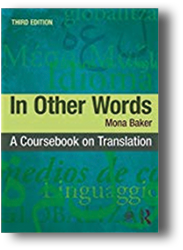 The third edition of this widely used translation studies textbook, In Other Words: A Coursebook on Translation, includes a new chapter on how to handle visual puns and other issues that may arise when the match between visual elements and text in one language (the source) cannot be easily replicated in another language (the target). Baker takes us text unit-by-text unit through potential problems and pitfalls when trying to transfer meaning from one linguistic system and culture to another. She starts with the smallest such unit, a single word, and moves through sentences and paragraphs to entire documents, including associated imagery. Beyond static text, Baker also discusses subtitling and translating other heavily visual media, such as comics. A chapter on ethical questions that both translators and interpreters may need to consider rounds out the book.
The third edition of this widely used translation studies textbook, In Other Words: A Coursebook on Translation, includes a new chapter on how to handle visual puns and other issues that may arise when the match between visual elements and text in one language (the source) cannot be easily replicated in another language (the target). Baker takes us text unit-by-text unit through potential problems and pitfalls when trying to transfer meaning from one linguistic system and culture to another. She starts with the smallest such unit, a single word, and moves through sentences and paragraphs to entire documents, including associated imagery. Beyond static text, Baker also discusses subtitling and translating other heavily visual media, such as comics. A chapter on ethical questions that both translators and interpreters may need to consider rounds out the book.
Each chapter includes examples from a variety of languages to illustrate the points discussed, extensive footnotes, a bibliography for further reading on the topic at hand, and suggested exercises. A glossary at the end explains the terms used throughout the book, but familiarity with the terminology used by linguists to dissect texts would be helpful before tackling the textbook.
Since this is a language-independent textbook, the exercises assume English as the source language—a slight problem for us into-English translators. All exercises ask the reader to reflect upon and explain the translation choices he/she makes. However, given the nature of the exercises, there is no answer key. Thus, the book is best used in educational or group settings where others may provide feedback.
The problems Baker raises are certainly worth contemplating, although they may be more applicable to working with literary or marketing texts rather than technical specifications or birth certificates. In the real world, however, deadlines and payment based on word count, not time spent, mean that many freelance translators rarely have time to ponder some of the finer points of implicatures or tone raised in this book.
Nonetheless, as a working translator without a formal background in the profession, I kept discovering issues that I had solved without necessarily thinking of them within a theoretical framework. Other problems were new to me but were interesting to contemplate anyway. Given the variety of languages used in the examples, I also learned interesting facts about, for example, Chinese or Arabic.
Even though In Other Words is a textbook for students of translation, those involved in writing source text or managing the translation process could benefit from reading it. The book’s thorough exploration of the various ways in which a target text may differ from its source can help non-translators appreciate—or possibly question—how their translators approach the project.
Barbara Jungwirth
Barbara Jungwirth owns reliable translations llc (www.reliable-translations.com), where she translates technical and medical documents from German into English. She also writes about medical issues (www.bjungwirth.com). Barbara was previously a technical writer and IT manager.
Thinking Globally, Composing Locally: Rethinking Online Writing in the Age of the Global Internet
Rich Rice and Kirk St.Amant, eds. 2018. Louisville, CO: Utah State University Press. [ISBN 978-1-60732-663-2. 366 pages, including index. US$39.95 (softcover).]
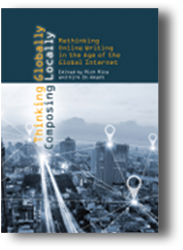 Thinking Globally, Composing Locally is an anthology with 15 chapters, plus an introduction and afterword by the editors. As Rice and St.Amant say, “We have inhabited digital landscapes for several decades…[but] the international online environment exists as a new terrain that must be continuously (re)examined and (re)mapped” (p. 341). This book brings us recent studies and new pedagogies from many cultures, including Egypt, Greece, Indonesia, Turkey, and Uganda, as well as the United States.
Thinking Globally, Composing Locally is an anthology with 15 chapters, plus an introduction and afterword by the editors. As Rice and St.Amant say, “We have inhabited digital landscapes for several decades…[but] the international online environment exists as a new terrain that must be continuously (re)examined and (re)mapped” (p. 341). This book brings us recent studies and new pedagogies from many cultures, including Egypt, Greece, Indonesia, Turkey, and Uganda, as well as the United States.
If you teach technical writing, you will find this book valuable both to devise new curricula and to assign case studies to your students. For example,
Josephine Walwema explains how a class can use digital notebooks to let students in several countries share ideas. Cross-cultural composition and discussion help all participants become better writers and more culturally aware.
J. C. Lee describes how an online global forum about amphibians requires all contributions to be in standard English. This is not to be old-fashioned, but to be sure everyone understands you (no regional idioms) and to help contributors from other languages improve their English language skills.
If you are a practicing technical communicator, you may find many of the chapters fascinating, as I did, even though this isn’t a “how-to” writing or editing guide. Some authors relay inspiring stories of their experiences in cultures other than their own. Some chapters made me think in new ways about the global audience who have access to our work. For example,
Amber Engleson’s ethnography of how her Indonesian students struggle to get access to the published articles they need for their research made me realize the truth of her statement that “Resources are power; they dictate who can add to the current global written conversations and what they can write about” (emphasis in the original, p. 170).
In her study of how an online campaign spread virally, but then ran into trouble, Lavinia Hirsu draws our attention to the difference between “spreadability” and “drillability.” The latter is about going deeper into the story. Passing on a tweet or liking a YouTube video isn’t the same as engaging in the reality and complexity of the content.
As Hirsu writes, “The teaching of traditional [rhetorical] concepts . . . needs to be supplemented with a pedagogy attuned to the realities of a global world in flux” (p. 270). Thinking Globally, Composing Locally can help teachers do that. It can also help practitioners appreciate just how global our reach is today.
Janice (Ginny) Redish
Janice (Ginny) Redish is President of Redish & Associates in Bethesda, Maryland, USA. Ginny’s “how-to” book, Letting Go of the Words – Writing Web Content that Works, will help you and your colleagues communicate successfully through your Web sites and social media. Ginny is an STC Fellow and a former member of the STC Board of Directors.
WordPress for Journalists: From Plugins to Commercialisation
LJ Filotrani. 2018. New York, NY: Routledge. 196 pages, including index. [ISBN 978-1-138-65202-6. US$39.95 (softcover).]
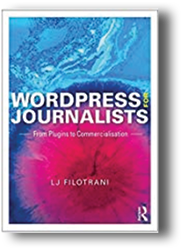 WordPress for Journalists: From Plugins to Commercialisation surprised me in how in-depth it covers its topics. Provided, it is not only information about how to complete tasks in WordPress but also how to use this content management system to produce journalism today.
WordPress for Journalists: From Plugins to Commercialisation surprised me in how in-depth it covers its topics. Provided, it is not only information about how to complete tasks in WordPress but also how to use this content management system to produce journalism today.
LJ Filotrani has an impressive background and is most qualified to tackle her topics. Not only is she an experienced journalist and web site editor and creator, she is also a Senior Lecturer in journalism at London South Bank University. She has a valuable perspective as she started her career in journalism working in trade publications and local press then joined the Guardian working completely online. She introduced blogs, podcasts, video, and other multimedia as she worked as a site editor for the Guardian and looked at how best to communicate a story. Her background in audio and video plus the experience of news and features gives her a great background to not only teach but also develop the impressive WordPress for Journalists.
This book could be an excellent textbook for students or reference book for practitioners. Students and practitioners could benefit from how the book explains how to set up a free site using WordPress.com (p. 12). Students and practitioners could also benefit from the section on setting up a self-hosted site using WordPress.org (p. 14). Also the commercialization sections are of value to students and practitioners. Filotrani notes in this section how difficult it is to make a profit with journalism online using the Guardian as an example (p. 172).
Jeanette Evans
Jeanette Evans is an STC Associate Fellow; active in the NEO community, currently serving on the newsletter committee; and is co-author of an Intercom column on emerging technologies in education. She holds an MS in technical communication management from Mercer University.
Applied Artificial Intelligence: A Handbook for Business Leaders
Mariya Yao, Marlene Jia, and Adelyn Zhou. 2018. USA: TOPBOTS Inc. [ISBN 978-0-9982-8902-1. 228 pages. US$19.95 (softcover).]
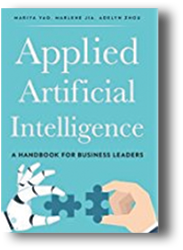 When you hear the words “artificial intelligence” what comes to mind? Robots doing work in factories? Characters from the movie Avengers? Or Deep Blue, the 1990’s chess-playing computer developed by IBM?
When you hear the words “artificial intelligence” what comes to mind? Robots doing work in factories? Characters from the movie Avengers? Or Deep Blue, the 1990’s chess-playing computer developed by IBM?
In Applied Artificial Intelligence: A Handbook for Business Leaders, the authors introduce artificial intelligence (AI), then proceed to address how to develop an enterprise AI strategy, and they describe the enterprise functions where it can be used, such as human resources, analytics, software development, marketing, sales, and customer support. In addition, the authors discuss the ethics of enterprise AI, as they point out that not everyone will equally benefit from the opportunities that AI will bring about; however, it will create the demand for new jobs requiring new skills.
The authors explain the benefits of AI to society, for example, pathology and radiology rely largely on trained human eyes to spot anomalies and these fields are now using computers that can interpret patient records with a 99-percent accuracy rate (p. 35).
Just as any good thing can be used for bad, the same goes for AI. Therefore, it is important to design safe, ethical AI.
Businesses are realizing the strength of AI and are on the forefront of developing an enterprise AI strategy. The authors provide suggestions for how we can prepare for the AI future. In business, it is important to choose the right champions of AI initiatives. Consider whether you need a Chief AI officer. The authors stress the importance of getting organizational buy-in by focusing on revenue potential, staying ahead of the competition, starting small, and showing early wins. “True leadership has to be demonstrated through vision, action, and budget” (p. 88).
Among the many areas where AI can be used is human resources. For example, Scout and SAP’s SuccessFactors help match, discover, and find candidates based on desired skills using AI techniques such as algorithmic matching.
The last chapter is a summary and additional resources, followed by end notes consisting of over 100 sources.
You can visit the authors’ website (appliedaibook.com) containing articles, resources, and a community link. Among the resources is an article that lists 100 examples of brand bots that are already in industries, such as Dom, the Domino’s Pizza chatbot, and Capital One’s Eno that can be used to track account balances, get bill due dates, and check recent transactions.
In summary, Applied Artificial Intelligence is an excellent high-level book that not only provides an overview of AI, but it quickly educates the reader on the basics for developing an AI strategy and the ethical responsibility involved when implementing this technology.
Rhonda Lunemann
Rhonda Lunemann is a technical writer with Siemens PLM Software, a senior member and serves on the Program Committee of STC’s Twin Cities Chapter, and a member of the MN (Minnesota) Bot Makers.
Ethics and Practice in Science Communication
Susanna Priest, Jean Goodwin, and Michael F. Dahlstrom, eds. 2018. Chicago, IL: The University of Chicago Press. [ISBN 978-0-226-49781-5. 306 pages, including index. US$40.00 (softcover).]
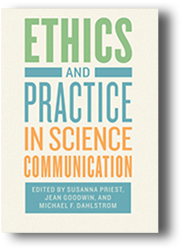 “Ethical considerations are not a supplementary component to the practice of science communication” (p. 9), a critical point that is effectively communicated and demonstrated in Ethics and Practice in Science Communication. For anyone involved in science communication, from scientist to student, this book is a valuable resource that illustrates how ethics is as much a part of science communication as clarity and engagement, which are ethical issues in and of themselves.
“Ethical considerations are not a supplementary component to the practice of science communication” (p. 9), a critical point that is effectively communicated and demonstrated in Ethics and Practice in Science Communication. For anyone involved in science communication, from scientist to student, this book is a valuable resource that illustrates how ethics is as much a part of science communication as clarity and engagement, which are ethical issues in and of themselves.
The book begins by explaining a common perspective on science communication: the “deficit model,” which is the assumption that the public is not engaged with or they are resistant to science due to a lack of scientific knowledge or scientific literacy; therefore, if there was increased and more clear communication, then the public would understand what needs to be understood. The problem with this model, as pointed out by several contributors, is it is not always accurate. This inaccuracy is challenged in Part I, How Ethics Matters, through alternative models for science communication taken from Speech Act Theory that depend on the role of the science communicator and “provide an account of science communication that respects audience members’ agency” (p. 29). Other chapters address public concerns in risk communication, goals and approaches to strategic and democratic science communication, especially when communicating controversy, and framing scientific issues for democratic engagement, which encourages citizens to reflect and deliberate on issues before deciding on a course of action.
Part II, Professional Practice, explores “diverse ethical challenges arising in particular contexts” (p. 91), such as the level of accuracy when using narrative in public policy and reflecting on the character of the scientist or science writer, especially considering “objectivity” and “truthfulness.” Discussion on persons and science communication continue with a review of expert sources most quoted and relied on by journalists and how this reliance affects what gets reported and how stories are framed. And the question of whether scientists have a duty to communicate with the public is also addressed.
Part III exemplifies previous chapters through case studies that illustrate the need for transparency in science communication, consumer concerns regarding genetic testing, controversial issues in agricultural biotechnology, how “meanings-in-use” or varying definitions, especially of “ethics” conflict, and the juxtaposition of science against non-science perspectives like religion and beliefs.
Readers who are familiar with science communication will recognize many of the topics in this book. However, what is new and enlightening is the angle on ethics. For instance, many studies and books emphasize the importance of using narrative in science communication to increase readability of information the public may otherwise have difficulty grasping, but as Dahlstrom and Ho point out, narratives may affect purpose, persuasive appeal, and level of accuracy. Likewise, Kruvand discusses ethical implications of journalists using celebrity scientists or the “overreliance on a limited number of expert sources” who can “affect the objectivity and balance of science and medical stories” (p. 150). The point here is that even if readers see familiar topics in the table of contents, ethical angles on these subjects have rarely been addressed before.
Diane Martinez
Diane Martinez is an assistant professor of professional and technical communication at Western Carolina University. She previously worked as a technical writer in engineering, an online writing instructor, and an online writing center specialist. She has been with STC since 2005.
Archive That, Comrade! Left Legacies and the Counter Culture of Remembrance
Phil Cohen. 2018. Oakland, CA. PM Press. [ISBN 978-1-62963-506-4. 142 pages, including index. US$19.95 (softcover).]
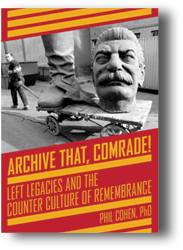 Archive That, Comrade! Left Legacies and the Counter Culture of Remembrance provides an informed outsider perspective on archives and their multiple roles in public memory. Cohen grounds his discussion in radical activist and social justice movements’ archives. While these movements may interest only a portion of technical communication (TC) professionals and academics, this book is not a social justice primer or handbook. Cohen’s text offers significant value regardless of the reader’s politics.
Archive That, Comrade! Left Legacies and the Counter Culture of Remembrance provides an informed outsider perspective on archives and their multiple roles in public memory. Cohen grounds his discussion in radical activist and social justice movements’ archives. While these movements may interest only a portion of technical communication (TC) professionals and academics, this book is not a social justice primer or handbook. Cohen’s text offers significant value regardless of the reader’s politics.
In depth and detail, Archive That, Comrade! discusses working with documents and the complexities of sorting, filing, organizing, and storing documents as well as non-traditional artifacts—especially when the artifacts are from underground, counter cultural, or politically fractious groups. Fanzine scholars, particularly librarians, have been addressing many of these same concerns for at least the past twenty years. Thus, for readers working with zine culture or with cultures that communicate and express with fanzines, flyers, posters, and other difficult to archive documents, Cohen offers good discussions of the challenges, another academic reference point to cite, and a leftist political view on how such artifacts can fit in the larger movement. He provides a solid introduction for those not familiar with zine culture or the diverse forms of printed expression many counter and subcultures use.
Connecting to several of TC’s goals, access, and communication, Cohen explores how some archives make their materials accessible to the public. Whether the issues are the physical buildings and spaces, concerns about rent or proximity to user populations, or how archives’ materials are organized and stored—as well as if individuals can copy or handle the artifacts themselves—are discussed to an extent. A bit more elaboration and depth in these areas would have been interesting, but there is certainly enough here for many TC scholars to connect.
Cohen also discusses some of the challenges or working with different communities to build collections. Determining how to avoid colonizing or perpetuating racist, gendered, or classist privilege is neither easy nor clear. No solution is offered; rather, Cohen reflects in a limited way on some of the immediate challenges he encounters. Building archives that serve diverse communities—even when some community members may not agree that the archives have any value—is touched on in several places.
Archive That, Comrade!’s text and tone are engaging. The book features an interesting mix of approaches. First is Cohen’s lived experience working with multiple projects and archives personally and professionally. Second, he visits, discusses, and describes two archives that serve different populations and have radically different funding. Third, he uses interviews to solicit additional information and perspectives on the archiving process.
Cohen is adept with academic and theoretical voices, but usually remains in a more accessible register. Archive That, Comrade! could work as a good introductory discussion to subcultures, archiving, document preservation, the political and social implications or archives, documenting and preserving social and cultural histories, or studying communication systems and artifacts within political and social movements as they occur.
Gregory Zobel
Gregory Zobel is an associate professor of Educational Technology at Western Oregon University.
Don’t Be Such a Scientist: Talking Substance in an Age of Style
Randy Olson. 2018. 2nd ed. Washington, DC: Island Press. [ISBN 978-1-61091-917-3. 236 pages, including index. US$19.99 (softcover).]
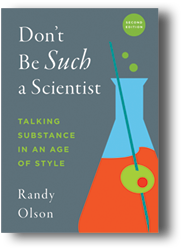 Science has important things to teach us, but often has difficulty making its case to the public. In Don’t Be Such a Scientist, Olson offers an approach grounded in the time-honored principles of storytelling.
Science has important things to teach us, but often has difficulty making its case to the public. In Don’t Be Such a Scientist, Olson offers an approach grounded in the time-honored principles of storytelling.
In the early 1990s Olson was a tenured professor of marine biology. Teaching and research were fine, but science needed spokespeople who could bridge the cultural divide and reach a larger audience.
With humor and humility, he tells how he gave up tenure, moved to Hollywood, enrolled in film school, took improvisation acting classes, and became an award-winning filmmaker (Flock of Dodos, about evolution and intelligent design, and Sizzle, about global warming).
The book’s title reflects Olson’s observation that, when it comes to reaching a broad audience, scientists—overly cerebral, literal minded, wanting only the facts, mistrusting of narrative, impatient of non-experts—can be their own worst enemies, and need to lighten up.
Reaching and engaging the public, Olson argues, requires addressing not just the head, but the heart (emotions) and the guts (intuition), and is best done through well-crafted narratives. Drawing on Joseph Campbell’s work on mythology and on leading books on screenwriting, Olson shows what goes structurally wrong with science communication. Scientists often attempt to make their points by just piling up more facts: and, and, and. But narrative requires a simple, but powerful, pattern of And, But, Therefore (ABT). The “and” sets the scene, the “but” introduces a problem or challenge that requires action, and the “therefore” relates what is done to meet the challenge. (Our environment was once clean but is now polluted. Therefore …). The pattern is universal, and once mastered, can help you craft anything from a compelling science-based argument, to an effective elevator speech.
Olson stresses that what he is recommending has nothing to do with making things up or bending the truth, but with selecting your most compelling facts and sequencing them to tell a story that will resonate with an audience. Simple as it is, putting the ABT pattern to work takes care, patience, and practice. With lots of entertaining examples, Olson shows how it’s done.
Those interested in Olson’s approach may also want his other books, Houston, We Have a Narrative, in which he expands on the art of applying storytelling to substantive information, and Connection, which is based on his workshops.
Patrick Lufkin
Patrick Lufkin is an STC Fellow with experience in computer documentation, newsletter production, and public relations. He reads widely in science, history, and current affairs, as well as on writing and editing. He chairs the Gordon Scholarship for technical communication and co-chairs the Northern California technical communication competition.
Scholarly Communication: What Everyone Needs to Know®
Rick Anderson. 2018. New York, NY: Oxford University Press. [ISBN 978-0-19-063945-7. 280 pages, including index. $16.95 (softcover).]
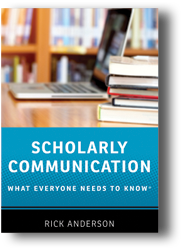 Anderson admits right off that he’s not expecting to sell any movie rights for this book. But he stresses that there are really many things that most people would clearly benefit from knowing. If, say, you’re interested in the progress being made towards a cure for cancer, or the effects of economic policies on people’s wages, then you have a vested interest in the scholarly communication “ecosystem.”
Anderson admits right off that he’s not expecting to sell any movie rights for this book. But he stresses that there are really many things that most people would clearly benefit from knowing. If, say, you’re interested in the progress being made towards a cure for cancer, or the effects of economic policies on people’s wages, then you have a vested interest in the scholarly communication “ecosystem.”
Given the unending stream of information coming at us from every side, it becomes more crucial that we have reliable ways of evaluating that information.
Scholarly communication “refers to the many different ways…authors and creators of scholarly and scientific work share information with each other and with the rest of the world about the work they are doing” (p. 5). The book’s theme is that more information is being transmitted online. And that change has affected everyone.
As the Web began maturing in the 1990s as a global disseminator of communication and publishing, scholarly journals joined the caravan. While many still appear in print format, the majority are consumed online. Rarely, if ever, do new journals appear in print format only.
Nothing is free; everything has a price. But the digitizing of knowledge has had some astounding effects. Take indexes, for example. In some online textbooks, the page numbers are hot; selecting a page number takes you immediately to the actual page.
Blogs have also become an important place for serious scholarly and scientific discourse. Quite a few professional societies maintain blogs for discussing important issues. Likewise, listservs are basically email discussion groups.
The Internet has also made it possible for almost anyone to publish inexpensively. If you want to publish a book, and make it freely available to the world, you can just open a free blog account and post it.
Digitization has also had a major impact on libraries. Over the past few decades, the location of scholarly books and journals has moved substantially online. This has had a profound effect on things like library budgets, as well as the actual size and changing functions of libraries themselves. It has also allowed them to acquire and store far more holdings than could be contained in paper books and periodicals on shelves. Centers like the Digital Public Library of America and the Gutenberg Project, the Library of Congress’ American Memory Project and the HathiTrust have digitized enormous quantities of material.
The HathiTrust, for example, includes almost 15 million books in its collection, including 20,000 titles from pre-1500. “No single research library in the world contains that many books from that period” (p. 171). Such resources allow you to carry on some sophisticated research, in a shorter period. And from almost anywhere in the world if you have an Internet connection. Where would you like to be writing your next book from?
Steven Darian
Steven Darian is an STC Fellow and retired from a career at Rutgers University, where he taught business and technical writing as well as other language-related courses. Steven’s most recent book is the second revised edition of “Technique in Nonfiction: The Tools of the Trade.”
The Paper It’s Written On: Defining Your Relationship with an Editing Client
Karin Cather and Dick Margulis. 2018. Andslash Books. [ISBN 978-1-7260-7329-5. 70 pages. USD$12.50 (softcover).]
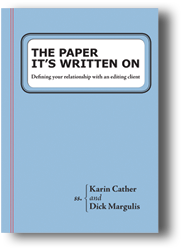 The Paper It’s Written On: Defining Your Relationship with an Editing Client fills the needs of an independent editor. Cather and Margulis ably tackle their subject matter with Cather being a former litigator and freelance editor working with academic works, memoirs, police procedurals, science fiction, thrillers, true crime, and fantasy (wow!). Margulis is an editor and book designer with over a decade of experience that includes helping authors be their own publishers.
The Paper It’s Written On: Defining Your Relationship with an Editing Client fills the needs of an independent editor. Cather and Margulis ably tackle their subject matter with Cather being a former litigator and freelance editor working with academic works, memoirs, police procedurals, science fiction, thrillers, true crime, and fantasy (wow!). Margulis is an editor and book designer with over a decade of experience that includes helping authors be their own publishers.
In looking at defining the relationship of the freelance editor with an editing client, the authors choose their topics carefully. Cather and Margulis keep in mind that the independent editor is a professional running a business who may hear they need a contract with every client, and other books do not address the needs of this situation, so this book fills the gap.
The Paper It’s Written On could prove to be practical and useful to an editorial freelancer. The kind of contract the authors discuss could help to prevent problems. The audience is an editorial freelancer looking to establish guidelines and/or set limits when working with a client. The information presented is useful and practical.
Of note are two sample contracts. One is Cather’s template (p. 53). The other is Margulis’s template (p. 60). Cather's template struck me as especially interesting when she requires payment up front before she provides her final deliverable. Margulis's template is especially interesting when he provides an à la carte menu with charges for each service including such items as line editing and project management. While the authors provide these contracts as examples, they also note that a contract can take on many forms and is simply an agreement. It can even take on the form of a series of emails provided both parties agree.
Jeanette Evans
Jeanette Evans is an STC Associate Fellow; active in the NEO community, currently serving on the newsletter committee; and is co-author of an Intercom column on emerging technologies in education. She holds an MS in technical communication management from Mercer University.
Introducing Science through Images: Cases of Visual Popularization
Maria E. Gigante. 2018. Columbia, SC: The University of South Carolina Press. [ISBN 978-1-61117-874-6. 140 pages, including index. US$39.99.]
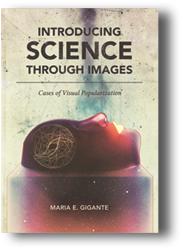 The public has always had a love/hate relationship with science. On one hand, science is celebrated in Western culture as a powerful tool for teasing out the truth from mere beliefs and “folk wisdom.” However, science is also sometimes seen to confuse and manipulate the general public, who may lack the scientific literacy necessary to interpret technical information. Scientific visuals play a vital, and often overlooked, role in not only illustrating and clarifying scientific information, but also in shaping public perception toward science itself. Maria E. Gigante’s Introducing Science through Images: Cases of Visual Popularization explores and dissects the history of these visuals from 300 years ago when science was known as natural philosophy to the modern age of science journals and periodicals.
The public has always had a love/hate relationship with science. On one hand, science is celebrated in Western culture as a powerful tool for teasing out the truth from mere beliefs and “folk wisdom.” However, science is also sometimes seen to confuse and manipulate the general public, who may lack the scientific literacy necessary to interpret technical information. Scientific visuals play a vital, and often overlooked, role in not only illustrating and clarifying scientific information, but also in shaping public perception toward science itself. Maria E. Gigante’s Introducing Science through Images: Cases of Visual Popularization explores and dissects the history of these visuals from 300 years ago when science was known as natural philosophy to the modern age of science journals and periodicals.
The main thrust of Introducing Science through Images is to discuss the use of, and best practices for, using scientific images in various scientific genres. Gigante begins by tracing the evolution of scientific images from “portal images,” or introductory images in early scientific works, to depictions of scientists at work, covers of popular scientific magazines and journals, and finally to the use of science visuals on the web and as stand-alone pieces in art contests. This broad treatment results in a panoramic view of the various uses of visuals in the sciences, but it also makes the book seem less cohesive than it could be. The discussion of the visuals differed so much in terms of genre, audience, and type of visual that the book read like a collection of disparate articles rather than an academic work on one unified theme.
Despite Gigante’s lamentation that she was unable to obtain some of the necessary permissions to display all the images under discussion, the book contains many representative illustrations. My only regret is that the images were not in color and many would have been easier to view if they were shown closer to their original scale. Many of Gigante’s assertions about the use of color and the fine details, like illustrations, lacked impact when shown to the reader on a smaller scale and in black and white.
Introducing Science through Images is worth recommending although it has some serious deficits in cohesiveness and in the visuals. This text is one of those rare academic books that has wide appeal. Gigante specifically and accurately outlines her audience as both scholars in rhetoric and related fields, such as information design, and science practitioners. Beyond these audiences, this book may have even broader appeal. Technical communicators working in the medical fields will certainly find much that is useful in this book, particularly when it comes to designing posters and visuals for the public. However, any professional interested in or working with the sciences will learn much from Gigante’s work. I have already recommended it to a colleague who specializes in the depiction of science in literature, as well as to a technical communicator who documents images for disaster remediation.
Nicole St. Germaine-Dilts
Nicole St. Germaine-Dilts is an Associate Professor of English in the Technical and Business Writing Program at Angelo State University. Her research interests include technical communication for international and intercultural audiences and technical communication in the health fields.
Breaking Down Barriers: Usability, Accessibility and Inclusive Design
Pat Langdon, Jonathan Lazar, Ann Heylighen, and Hua Dong, eds. 2018. Cambridge, UK: Springer. [ISBN 978-3-319-75027-9. 286 pages, including index. US$199.00.]
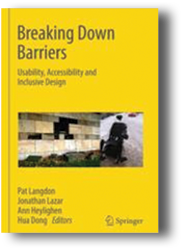 Technical communicators interested in learning about the inclusive design aspect of User Experience will find Breaking Down Barriers: Usability, Accessibility and Inclusive Design both fascinating and inspiring. In this book, the editorial committee of the Cambridge Workshops on Universal Access and Assistive Technology (CWUAAT) provides a collection of twenty-four enlightening scholarly papers presented at those workshops in April 2018.
Technical communicators interested in learning about the inclusive design aspect of User Experience will find Breaking Down Barriers: Usability, Accessibility and Inclusive Design both fascinating and inspiring. In this book, the editorial committee of the Cambridge Workshops on Universal Access and Assistive Technology (CWUAAT) provides a collection of twenty-four enlightening scholarly papers presented at those workshops in April 2018.
Each paper provides details with supporting graphics highlighting the creativity, collaboration, and compassion so many are using to help physically and emotionally impaired people live better lives. The CWUAAT editorial committee organized the papers into five parts based on broad themes they “…identified in the emerging field of design for inclusion” (p. v).
Part 1 highlights breaking down barriers between disciplines. Too often, technical, medical, and civic communities lack good communication as they work to solve significant community problems. This section includes a case study highlighting how two neighboring communities in Ireland, striving to reduce tragically high suicide rates, revamped their common architecture and environment to inspire hope in their citizens.
Part 2 focuses on breaking down barriers between users, designers, and developers. Everyone benefits when designers have a better understanding of the capability needs of end users. This section includes a case in which physically impaired architects provided consult on developing more accessible swimming pool designs.
Part 3 discusses removing barriers to usability, accessibility, and inclusive design. Here, the editors highlight how user centered designs and human-computer interaction address the challenges of aging. Papers in this section cover improving usability designs for people with dementia, impaired vision, and lost mobility due to stroke.
Part 4 discusses breaking down barriers between people with impairments and those without. One paper in this section highlights a ten-year effort in an undergraduate computing class establishing partnerships between students and impaired computer users outside the university. Student comments about the course include, “…the class is a ‘must-take’…it really helped me understand people with disabilities better” (p. 178).
Part 5 addresses barriers between research and policymaking. Accessibility gaps still exist despite laws enacted to close them. Papers in this section discuss password policy development and education of architects ensuring improved accessibility for older people.
Additionally, there are papers describing autonomous automobile solutions, improved smart speaker solutions for veterans with mild brain injuries, and improved cancer care environments. Collectively, the papers in this book highlight “…a user-centered approach…to make someone’s life easier and more productive” (https://www.stc.org/about-stc/defining-technical-communication/).
Technical communicators will find Breaking Down Barriers a worthwhile read as they learn what work is going on to advance inclusive design methods. All readers will be encouraged to learn how so many teams, communities, and companies around the world are working to improve the lives of so many people.
Scott Fouse
Scott Fouse is an STC member and a student in Dr. Ryan Weber’s Theory and Practice of Technical Communication course at the University of Alabama in Huntsville. Scott works at the Defense Acquisition University as both a professor and consulting support coordinator.
A Connected Curriculum for Higher Education
Dilly Fung. 2017. London, England: UCL Press. [ISBN 978-1-911576-34-1. 168 pages, including index. USD$30.00 (softcover).]
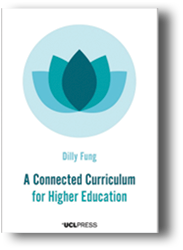 A Connected Curriculum for Higher Education calls us to return radical self-improvement to the great modern university. In a world where “fake news” is growing and expertise is frequently disdained, students should no longer be satisfied with a limited set of discipline-based skills. They should ask how knowledge itself is unearthed: How is it found, tested in extended dialogue with others, and collectively understood? And how can they learn to respond uniquely to the unfamiliar, different, and disturbing in our world?
A Connected Curriculum for Higher Education calls us to return radical self-improvement to the great modern university. In a world where “fake news” is growing and expertise is frequently disdained, students should no longer be satisfied with a limited set of discipline-based skills. They should ask how knowledge itself is unearthed: How is it found, tested in extended dialogue with others, and collectively understood? And how can they learn to respond uniquely to the unfamiliar, different, and disturbing in our world?
The bracing answer to these questions comes from the Connected Curriculum framework introduced in 2014 at the University College of London. The framework is a set of six “values-based dimensions” that, when adopted together, can produce a dialogue-provoking thread across the academic curriculum. As to these dimensions, the adjective “values-based” is important—the book aims to shift education from simply training students in employable skills toward cultivating in them a powerful, lifelong curiosity and capability for intellectual and civic growth.
What are the dimensions of the framework, and more importantly, how do you get them all to work together? Often, an activity hits multiple dimensions at once. For instance, materials science and physics students on a chemistry research team who create a research poster will work across disciplines (dimension 3), connect with each other and various students (dimension 6), produce an output directed at an audience (dimension 5), and connect with a researcher at their institution (dimension 1). If they produce a material useful to the world, they will also have connected workplace and academic learning (dimension 4).
Each chapter covers a dimension which includes a philosophical justification, including multiple academic references, and multiple practical vignettes from various universities, mostly in the U.K. The vignettes come from disciplines including history, physics, biomolecular science, language classes, business, chemistry, economics, archaeology, and so on. Some show add-on, co-curricular programs (such as two-week summer experiences or mandatory, ungraded seminars), and others show activities embedded in the curriculum (such as physics concept videos in a physics course or the clinical shadowing of medical providers). For any educator looking for ideas, the vignettes alone are worth a look.
The largest question is how to thread the dimensions across an entire curriculum. Chapter 4 offers multiple paths to “connected program design”, each featuring repeated check-ins on student learning and opportunities for feedback to students. For instance, the curriculum could be arranged around a real-world event (climate change) or it could feature a series of mandatory modules or a single linear module from start to finish (with multiple checkpoints for student knowledge acquisition.) The most interesting idea was a curated, summative portfolio (the “Showcase Portfolio”) which the students could shape and edit throughout the length of the program.
The Showcase Portfolio would be terrific evidence of an informed citizen who is able to understand knowledge generation and engage productively with uncertainty. It would also be a great thing to take to a job interview.
Jake Ashcraft
Jake Ashcraft is an STC member and a chemistry professor at South Seattle College. He has worked for more than 15 years as a writer, manager, and educator in the scientific sector, focusing on scientific communication. Jake has an MS in Technical Communication from the University of Washington.

